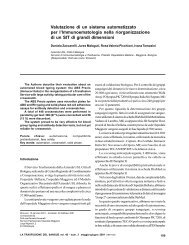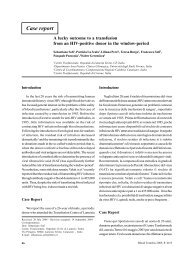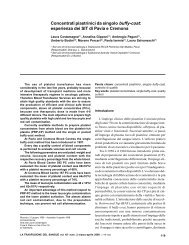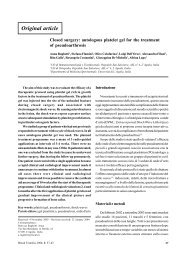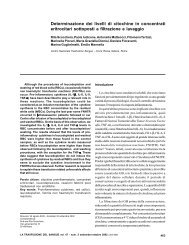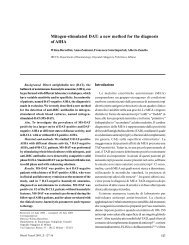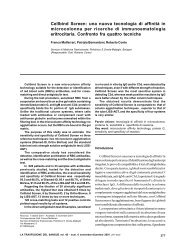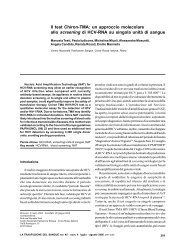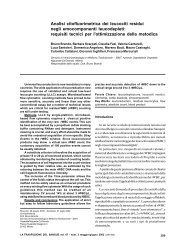Mathematics and transfusion medicine - Blood Transfusion
Mathematics and transfusion medicine - Blood Transfusion
Mathematics and transfusion medicine - Blood Transfusion
You also want an ePaper? Increase the reach of your titles
YUMPU automatically turns print PDFs into web optimized ePapers that Google loves.
Reverberi R , Reverberi LChoosing the haematocrit of the blood to betransfusedIt has been noted that the haematocrit of the transfusedblood does not influence the efficiency of the procedure<strong>and</strong>, therefore, it may be chosen on the basis of otherconsiderations: the haematocrit should not be too low, inorder not to induce a state of anaemia <strong>and</strong> to correct it, ifpresent; an elevated haematocrit at the end of the procedureexerts an inhibitory effect on autologous marrowproduction, which is in any case destined to precociousdestruction. On the other h<strong>and</strong>, an excessive haematocritof the transfused blood limits the total exchanged volume,lest the neonate be made too polycythaemic 6 . This entailsthe risk of an insufficient exchange 6 . Since the 1950s, it hasbeen customary to concentrate the reconstituted wholeblood up to a haematocrit of about 50% 6 . This practice wasconfirmed by the recent Italian guidelines 8 . Probably, thischoice stems from the fact that the normal neonatalhaematocrit is about 50%. Such an elevated haematocrit isdue to the greater affinity for oxygen by the foetalhaemoglobin that, therefore, has a lower oxygen carryingcapacity to the tissues. In fact, haematocrit rapidlydecreases in the weeks following birth. After about 2months, even though the substitution by adulthaemoglobin is not complete, the haematocrit has fallen toabout 35% 9 . Therefore, a haematocrit of 50% is notnecessary <strong>and</strong> it could be decreased to 45% or less, so asto profit from the greater volume of reconstituted wholeblood available to increase the removal of neonatal redcells or bilirubin.Exchange <strong>transfusion</strong> in the therapyof sickle cell anaemiaExchange <strong>transfusion</strong> is used preferentially or as analternative to simple <strong>transfusion</strong> in a number of indicationsin children with sickle cell anaemia 10 . In adults or biggerchildren, automated red cell exchange is the preferredprocedure (this topic will be dealt with in the next article ofthis series), but the manual exchange of whole blood maybe necessary for smaller children, given the limitations inthe extracorporeal volume. In this case, the removal kineticsis the same as that described above. The difference lies inthe target, which is not to remove as many autologous redcells as possible, but to reduce the percentage ofhaemoglobin S without increasing the haematocritexcessively, in order not to cause a high blood viscosity 11 .The relevant parameters are, therefore, the percentageof haemoglobin S <strong>and</strong> the venous haematocrit. This lattercan be calculated from (3). The first part of equation (3)represents the contribution (H p) of the residual autologousred cells (see Appendix A):⎛ s ⎞Hp = ⎜ 1 − ⎟ × HV⎝ kV ⎠Therefore, the percentage of haemoglobin S after ncycles (HbS n) will be:HpHbSn = × HbS0Hwhere HbS 0is the initial percentage of haemoglobin S.Limitations of the formulaeMost of the terms contained in the formulae can bemeasured with precision. However, blood volume is, usually,only estimated with the aid of a formula 12 <strong>and</strong> the value ofthe correction for the body haematocrit is taken from theliterature 7 . In this regard, however, it should be noted thatthe value may differ from the normal significantly, in caseof splenomegaly 13 .Moreover, the formulae assume that:- there is no dead space in the <strong>transfusion</strong> set used forthe exchange;- the transfused blood mixes immediately in thecirculation;- the blood volume does not change during theprocedure;- all transfused red cells survive in the circulation (atleast till the end of the exchange);- the patient's red cells are not destroyed during theprocedure.As regards the first assumption, after the <strong>transfusion</strong>step, before blood is again withdrawn, it is advisable toaspirate a small volume of blood from the patient <strong>and</strong> toreinfuse it. The second <strong>and</strong> third assumptions are plausible.The fourth is also plausible, in the case of HDN, becausethe neonate's reticuloendothelial system shouldpreferentially remove the sensitised autologous red cells.Finally, the fifth assumption depends on the duration ofthe procedure.ConclusionsThe exchange is more efficient if blood is first withdrawn<strong>and</strong> if the volume exchanged at each cycle is large. However,when the cycle volume does not exceed 10% of the patient'snn96<strong>Blood</strong> Transfus 2007; 5: 93-101 DOI 10.2450/2007.0018-07093-101_reverberi.p65 9609/07/2007, 9.53



